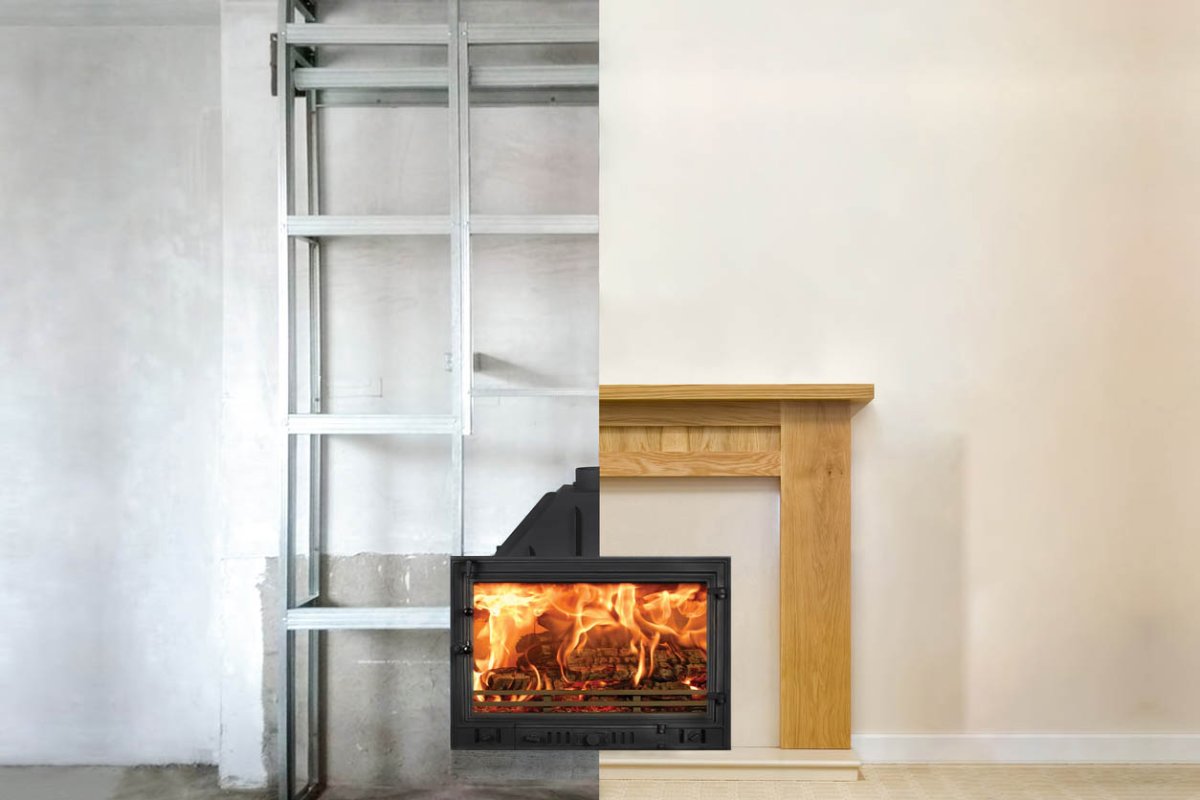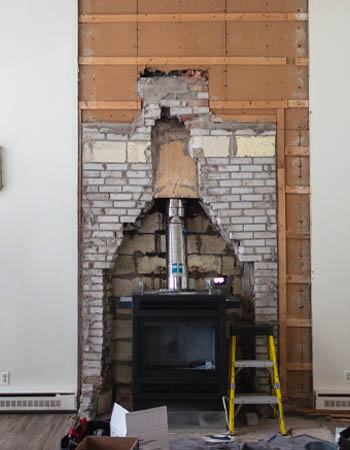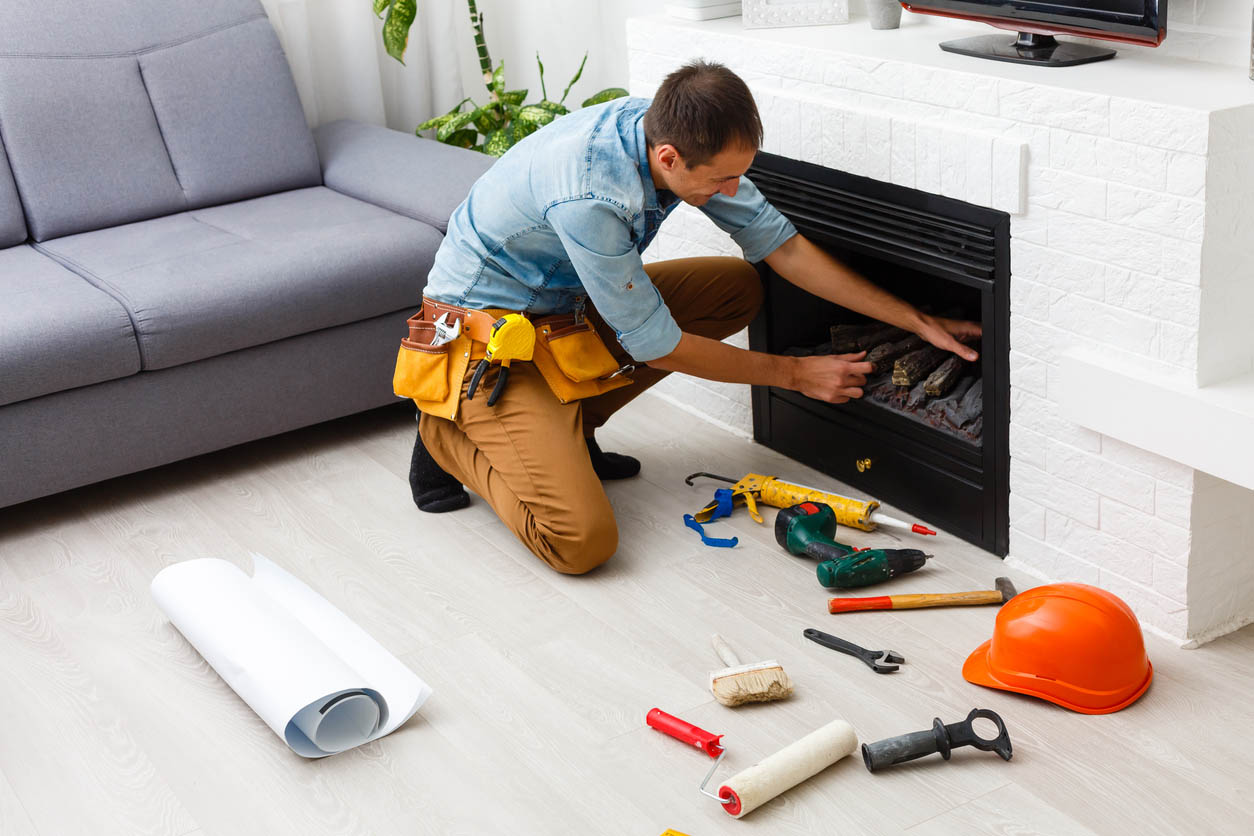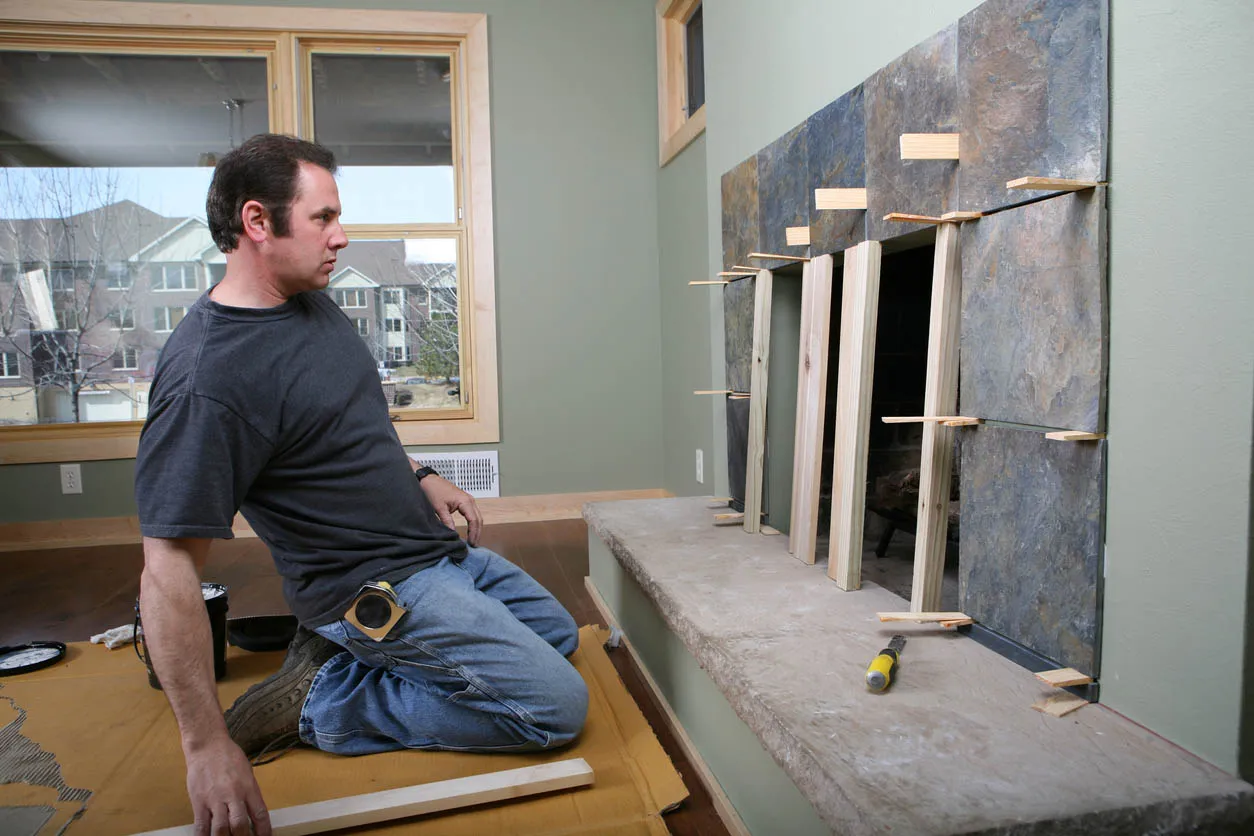

We may earn revenue from the products available on this page and participate in affiliate programs. Learn More ›
- Typical Range: $870 to $3,792
- National Average: $2,314
When snowflakes are swirling and Old Man Winter is howling at the windows, nothing offers a cozy ambience quite like a fireplace. Historically, fireplaces were gathering points in a home, and for a good reason: They heated the space while other rooms remained uncomfortably cold. Modern HVAC systems have changed that, but many homeowners still long for the warmth and intimacy that comes from sitting by a fireplace.
Fireplace installation cost varies widely based on the type and size of the unit and whether any venting provisions are already in place. In general, most can expect to pay about $2,314 for fireplace installation within a broader range of around $870 to $3,792.
Factors in Calculating Fireplace Installation Cost

The reasons for selecting one type of fireplace over another include personal taste, style, budget, and home layout. While most homeowners will spend a national average of around $2,314, many variations are possible, and those will affect the final cost.
Labor
The going cost of labor in a community figures prominently in the price a homeowner will pay for fireplace installation. Installation for some types of fireplace costs more because more labor is required. For example, the labor cost for installing an electric fireplace insert averages $225, while the labor cost for installing a wood-burning fireplace runs closer to $2,180. The more work that’s involved, the higher the labor costs.
Fireplace Type, Material, and Style
Perhaps the most significant cost variable depends on the type of fireplace selected. When contemplating how to install a fireplace, consider that wood-burning stove installation (not just an insert) averages $3,000 to $4,000 because special ventilation is required, as well as the installation of noncombustible wall coverings to protect nearby walls. On the other hand, simply converting a gas fireplace to accommodate a wood-burning stove can run less than $300 as long as adequate venting is in place.
Ventilation
Ventilation is necessary to use wood-burning stoves or fireplaces or combustible gas fireplaces, and it must meet local building codes. Without adequate ventilation, smoke and toxic fumes can seep into the home and endanger residents. The cost of installing ventilation depends on whether there is any existing ventilation and if it needs upgrading.
Wiring
Homeowners expect to need electrical wiring for running an electric fireplace. Still, they may not realize that wiring is also required for many gas and wood fireplaces and all pellet stoves. Modern fireplaces, stoves, and inserts feature fans that blow hot air into the room rather than allowing it to escape through the chimney to increase energy efficiency. Pellet stoves need electricity for fans and the pellet hopper that feeds the pellets into the burn chamber. Wiring services add about $140 to $200 to the installation cost.

Additional Costs and Considerations
Other costs factor into the average price most homeowners will pay for fireplace installation, such as whether the fireplace is an insert or a custom job. Changing the home’s structure or remodeling to accommodate a new fireplace should also be considered. Some additional costs may not be evident at first, such as the need to install a liner in an existing chimney or have a technician run gas lines to power a gas fireplace.
Prefab vs. Custom
Both gas and electric fireplaces and inserts are prefabricated since both require standard, sealed safety components installed by the manufacturer. Wood-burning stoves and wood fireplaces are a different matter. Just the cost of purchasing a wood-burning stove averages $325 to $4,000, depending on quality—and that doesn’t include the labor for installation.
Fees for installing a wood-burning stove are an additional expense. Installing wood-burning fireplace inserts (not stoves) runs from $700 to $6,500. Those looking for high-end, custom construction of a wood-burning fireplace with no existing fireplace are looking at a substantially higher cost of up to $30,000, including the services of a mason to lay a stone or brick hearth and surround.
Customizations
It’s not unusual for professional installers to customize prefabricated stoves and inserts to meet local building code requirements or aesthetic purposes. Customizing can be as minor as installing a fireproof board on a nearby wall, which could run as little as $100. However, as the customization’s depth and scope increase, the cost can go up significantly.
Remodeling
Remodeling is usually necessary unless the home is brand new and already designed for a fireplace. Remodeling will vary depending on the individual situation. It can include installing a flue ($400 to $2,000), constructing a wood or masonry surround and mantel, or updating an existing firebox to make it more energy efficient.
Chimney Liner Installation
The heat that rises from a gas or wood-burning fireplace is substantial, so the fireplace installer must take precautions to protect the house from catching fire. Installing a fireproof chimney liner adds an average of $2,500 to the final project price. In some communities, the cost could run as much as $7,000, depending on the liner material and the chimney’s length.
Removing an Existing Fireplace
The best place for a new fireplace is often in the same spot as an older one. Unfortunately, if the older fireplace’s bricks, chimney, and flue are not in good condition, the homeowner may want to remove the old fireplace and have a new one constructed. Removing an existing fireplace can reveal a lot of unseen surprises, such as uncovering wood rot if the roof around a chimney has been leaking or the need to stabilize the structure as the old fireplace and chimney are taken down.
The final cost will depend on the individual situation and the homeowner’s desires, but the fireplace and chimney removal can run $4,000 to $10,000 or more, depending on the project’s scope.
Gas Line Installation
All types of gas fireplaces and inserts require running a gas line from a large propane tank or a municipal gas line that services the home. Most communities require gas-line connections to be made by a licensed technician to reduce the risk of a faulty connection leaking toxic gases into the house or creating a fire hazard. A gas line installed and connected ranges from $120 to $1,350.
Converting a Gas Fireplace Into a Wood-Burning Stove
In some cases, it’s possible to convert an existing gas fireplace to hold a wood-burning stove. The caveat is that a suitable flue must already be in place. Converting from gas to a wood-burning stove can run as little as $100 to $300. If no flue is in place, new ventilation provisions must be made, which could run as high as $2,000.
Inspection, Cleaning, and Repairs
Electric fireplaces and inserts do not create soot, so there’s generally no need to clean an electric unit. Gas fireplaces create minimal soot, but wood-burning fireplaces can create a large amount, along with creosote deposits, that settle in the chimney. These deposits can increase the risk of fires or backed-up fumes in the house. A chimney and fireplace inspection and cleaning ranges from $129 to $378 and should be performed annually before winter. If damage is discovered, repair costs could add more.

Fireplace Types
Some types of fireplace inserts are more straightforward to install than others, but keep in mind that individual situations vary and affect the final cost.
Gas
Many homeowners prefer gas fireplaces because they produce heat without a wood-burning fireplace’s mess or smoky smell. Still, a licensed professional must install the gas line that supplies a gas fireplace. On average, it costs around $1,500 to install a gas insert, not including the cost of the fireplace unit itself.
Wood
The rustic intimacy of burning wood lures many, and if users can harvest their own firewood, it can be a good source of affordable heat. Wood-burning fireplaces, however, produce extremely hot flames as well as smoke and soot, which require the installation of an adequate flue and chimney liner. The cost to install wood-burning fireplace components with high-end finishes—starting from scratch—can run as much as $30,000. Naturally, smaller projects will run less.
Electric
The electric fireplace, which is typically the least expensive of all fireplaces to install, is safer overall because it does not use combustible gas or wood for heating. Installing an electric fireplace insert can run as little as $225 because no flue or chimney is necessary to operate the fireplace. Be aware, however, that in many communities, electricity is more expensive than natural gas, propane, or wood, so don’t be surprised if the electric bill jumps.
Wood Stove
Like wood fireplaces, wood stoves require adequate ventilation and heatproof materials around the flue to protect the house from fire. Wood stove installation costs between $3,000 to $4,000 on average, not counting the price of the stove, and costs will vary depending on the height of the stovepipe and whether a flue can be updated or must be newly installed.
Insert
An insert—typically a self-contained firebox that fits into the existing firebox of an older wood-burning or gas fireplace—is less expensive to install than a new fireplace from scratch would be. Installing a brand-new custom wood fireplace can run as much as $30,000, including building a firebox, installing a code-compliant flue, and creating a hearth. In comparison, having a gas insert installed in an existing firebox runs about $2,180.
Benefits of Installing a Fireplace
Even when HVAC technology offers uniform heating and cooling of an entire home via a smart thermostat, fireplaces are still a big draw. Here are some of the main perks.
Energy Efficiency
With utilities skyrocketing in many communities, installing a wood-burning fireplace that provides heat without running up the bills may make sense. Plus, when the family gathers in one room around a central fireplace, other rooms don’t have to be heated simultaneously, which can save money on utilities.
Decor and Aesthetic
When potential home buyers discover a fireplace during a house tour, it often brings oohs and aahs because a fireplace serves as a desirable focal point in a room. Just the appealing visual of a masonry fireplace with a large wall-to-wall hearth creates a feeling of warmth, home, and family. Many can picture using the room for entertaining guests or just relaxing by a cozy fire after a stressful day at work.
Dependable Resource
When winter snow and ice storms move in, electrical lines can go down. Having a gas or wood fireplace can provide lifesaving heat when they do. This, of course, depends on the homeowner’s foresight in harvesting enough wood or making sure the propane tank is full before a storm hits. For those who fancy living off-grid, a wood or propane gas fireplace offers the means to make it through a storm unscathed.
Return on Investment
While the actual return on investment (ROI) for money spent having a fireplace installed will vary, in most situations, a lovely fireplace or wood-burning stove will not only add to a home’s value but will also serve as a selling point. The caveat is that the fireplace, insert, or stove must be installed to meet local codes and pass inspections as being safe to operate. In some cases, homeowners can recover up to (or over) 100 percent of the cost to install the fireplace.

Fireplace Installation: DIY vs. Hiring a Professional
While many projects around the house are suitable for DIYers, installing a fireplace isn’t one of them—with the exception being electric fireplace insert installation. An electric fireplace doesn’t require venting, and in many cases, the fireplace can be hung on a wall (depending on the type) or used inside an old fireplace firebox. The only aspect of installing an electric fireplace that might require the services of a professional is if a direct wire must be run from the fireplace to the home’s electrical panel. Those wanting to know how to install a wood stove or a gas or wood fireplace should know that homeowners are prohibited from installing them in many communities because they present a safety risk if not installed correctly.
How to Save Money on Fireplace Installation
Even though fireplace installation is best left to the pros, homeowners can save some money if they perform certain aspects of the project themselves and consider wise fireplace placement.
- Offer to do the prepping. This may include removing an old fireplace insert and cleaning the area before the installer arrives.
- Opt for an insert over an entire fireplace install. Inserts make use of the existing firebox, hearth, and chimney, which saves a lot over having a fireplace installed from scratch.
- Do the cleanup yourself. It’s not the most fun part of the project, but it has to be done, and if a homeowner does it, it will save on labor costs.
Questions to Ask About Fireplace Installation
Having a fireplace installed can be a pricey prospect, especially if it’s a new, custom fireplace, so it makes sense to ask the installer some questions before signing on the dotted line.
- Are you NFI (National Fireplace Institute) certified?
- Are you insured?
- What are the local building codes on fireplace installation?
- Do you have experience installing this kind of fireplace?
- What type of chimney liner do you recommend?
- How much will the project cost?
- What unforeseen costs could crop up?
FAQs
Fireplaces can add value to a home, be a selling point, and offer relaxing enjoyment and energy savings. But they can also be costly. Those longing to enjoy the welcoming ambience of a fireplace will likely have some questions.
Q. Can I add a fireplace to an existing house?
Yes, in most cases, but it will ultimately depend on local building codes, available budget, and whether your home insurer will approve the installation.
Q. Does a fireplace add value to a home?
Most of the time, yes, it does. It can add as much to the value as it costs to have it installed, meaning the homeowner may realize a 100 percent ROI on the cost of the fireplace when the house sells.
Q. Does a fireplace increase the cost of home insurance?
Yes, it almost certainly will—if the insurer will even insure damages from a fire that originates in a fireplace. Some won’t.
Q. How does a fireplace insert work?
A fireplace insert is a sealed unit that fits into the opening of an existing fireplace. Depending on the type (gas or wood), local building codes may require additional remodeling to the firebox and chimney flue.
Q. Are outdoor fireplaces expensive?
They start around $3,000 for professional installation, but some run much higher.
Q. How long do fireplaces last?
Depending on quality, a gas fireplace can last from 10 to 20 years, while an electric fireplace lasts around 10 years. A wood-burning fireplace can last for the life of the house if it’s well built and meets code.
Q. How often should I clean my fireplace?
Clean out ashes that collect in the firebox after each use to keep downdrafts from blowing them around the room. Have a professional chimney sweep clean the chimney at least once per year—preferably in late fall before cold weather arrives.
Q. Where should I place a fireplace?
Fireplaces are often the most effective at heating when located in the center of the house or a large family room. Freestanding models can even be placed between two rooms, such as between a kitchen and dining room or between a dining room and a family room.
Sources: HomeAdvisor, Kozy Heat Fireplaces
